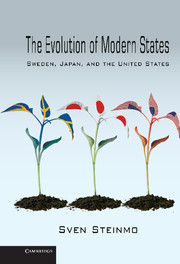2 - Sweden: The Evolution of a Bumble Bee
Published online by Cambridge University Press: 05 June 2012
Summary
There is much to admire about Sweden. Whereas in the late nineteenth century hundreds of thousands of Swedes were faced with the grim choice of either leaving their homeland or starving to death, by the 1970s Sweden had the highest per capita income in the world. Today, not only is the country rich, but virtually everyone shares in the country's good fortune. Swedes are some of the most highly educated people in the world, take the longest vacations, have one of the best health care systems, live the longest, are exposed to very low levels of crime and enjoy one of highest standards of living in the world (see World Bank, Human Development Index). At the same time, the economy is productive, efficient and dynamic. Finally, the government is democratic, highly stable and widely regarded as a model of tolerance and progressive idealism. Swedish Prime Minister Göran Persson nicely captured the irony of Sweden's success: “Think of a bumblebee. With its overly heavy body and little wings, supposedly it should not be able to fly – but it does.” It is a small wonder then that a virtual army of academics, labor union officials and politicians from around the world flock to Sweden to see exactly how this surprising system has been constructed. Table 2.1 suggests some of the reasons why.
- Type
- Chapter
- Information
- The Evolution of Modern StatesSweden, Japan, and the United States, pp. 30 - 87Publisher: Cambridge University PressPrint publication year: 2010
- 2
- Cited by

